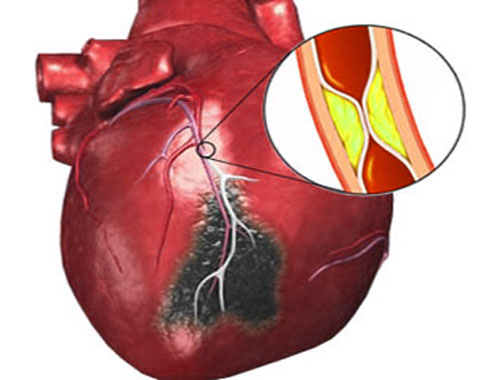Heart Attack, Myocardial Infarction (AMI)

Published: 18 Jun 2025
ICD9: 410.90 ICD10: I21.3 ICD11: BA41
A heart attack, also known as a myocardial infarction (MI) or acute myocardial infarction (AMI), is a serious medical emergency that occurs when the blood supply to a part of the heart is severely reduced or completely blocked.
This blockage is most often caused by a buildup of fat, cholesterol, and other substances, which form a plaque in the arteries that feed the heart (coronary arteries). When a plaque ruptures, it can lead to a blood clot forming, blocking blood flow.
Here's a breakdown of the key components:
![]() Myocardial: Refers to the heart muscle.
Myocardial: Refers to the heart muscle.
![]() Infarction: Refers to tissue death (necrosis) due to a lack of blood supply.
Infarction: Refers to tissue death (necrosis) due to a lack of blood supply.
![]() Acute: Means sudden or happening in a short period of time.
Acute: Means sudden or happening in a short period of time.
In simpler terms:
Imagine the heart is a car engine. The coronary arteries are like the fuel lines supplying the engine with fuel (oxygenated blood). If one of those fuel lines gets clogged (blocked artery), that part of the engine (heart muscle) doesn't get enough fuel and starts to die. That's a heart attack.
Key Consequences:
![]() Heart Muscle Damage: The lack of blood flow deprives the heart muscle of oxygen. If blood flow isn't restored quickly, the heart muscle begins to die.
Heart Muscle Damage: The lack of blood flow deprives the heart muscle of oxygen. If blood flow isn't restored quickly, the heart muscle begins to die.
![]() Reduced Heart Function: The damaged heart muscle may not be able to pump blood as effectively as it used to, which can lead to heart failure, arrhythmias (irregular heartbeats), and other complications.
Reduced Heart Function: The damaged heart muscle may not be able to pump blood as effectively as it used to, which can lead to heart failure, arrhythmias (irregular heartbeats), and other complications.
![]() Life-Threatening: Heart attacks can be fatal if not treated promptly.
Life-Threatening: Heart attacks can be fatal if not treated promptly.
Common Symptoms:
While symptoms can vary from person to person, and some heart attacks can be "silent" (without noticeable symptoms), common signs and symptoms include:
![]() Chest pain or discomfort: This is the most common symptom. It may feel like pressure, tightness, squeezing, aching, or burning in the center or left side of the chest. It can last for more than a few minutes or go away and come back.
Chest pain or discomfort: This is the most common symptom. It may feel like pressure, tightness, squeezing, aching, or burning in the center or left side of the chest. It can last for more than a few minutes or go away and come back.
![]() Pain or discomfort in other areas of the upper body: This can include pain in the arms, left shoulder, back, neck, jaw, or stomach.
Pain or discomfort in other areas of the upper body: This can include pain in the arms, left shoulder, back, neck, jaw, or stomach.
![]() Shortness of breath: May occur with or without chest discomfort.
Shortness of breath: May occur with or without chest discomfort.
![]() Cold sweat
Cold sweat
![]() Nausea or vomiting
Nausea or vomiting
![]() Lightheadedness or dizziness
Lightheadedness or dizziness
![]() Unexplained fatigue
Unexplained fatigue
Important Considerations:
![]() Time is crucial: The faster a person receives treatment for a heart attack, the better the chances of minimizing heart damage. If you think you or someone you know is having a heart attack, call emergency services (911 in the US) immediately. Do not drive yourself to the hospital.
Time is crucial: The faster a person receives treatment for a heart attack, the better the chances of minimizing heart damage. If you think you or someone you know is having a heart attack, call emergency services (911 in the US) immediately. Do not drive yourself to the hospital.
![]() Risk factors: Several factors increase the risk of heart attack, including:
Risk factors: Several factors increase the risk of heart attack, including:![]()

![]() Age
Age![]()

![]() High blood pressure
High blood pressure![]()

![]() High cholesterol
High cholesterol![]()

![]() Smoking
Smoking![]()

![]() Diabetes
Diabetes![]()

![]() Obesity
Obesity![]()

![]() Family history of heart disease
Family history of heart disease![]()

![]() Lack of physical activity
Lack of physical activity![]()

![]() Stress
Stress
Treatment:
Treatment for a heart attack typically involves:
![]() Medications: To break up blood clots, thin the blood, reduce heart workload, manage pain, and stabilize heart rhythm.
Medications: To break up blood clots, thin the blood, reduce heart workload, manage pain, and stabilize heart rhythm.
![]() Procedures: Such as angioplasty (inserting a balloon-tipped catheter to open a blocked artery) or bypass surgery (creating new routes for blood to flow around blocked arteries).
Procedures: Such as angioplasty (inserting a balloon-tipped catheter to open a blocked artery) or bypass surgery (creating new routes for blood to flow around blocked arteries).
![]() Rehabilitation: Cardiac rehabilitation programs to help patients recover and adopt heart-healthy lifestyle changes.
Rehabilitation: Cardiac rehabilitation programs to help patients recover and adopt heart-healthy lifestyle changes.
In summary, a heart attack (myocardial infarction) is a life-threatening condition caused by a blockage of blood flow to the heart muscle, leading to tissue damage. Prompt recognition of symptoms and immediate medical attention are crucial to minimize heart damage and improve survival.